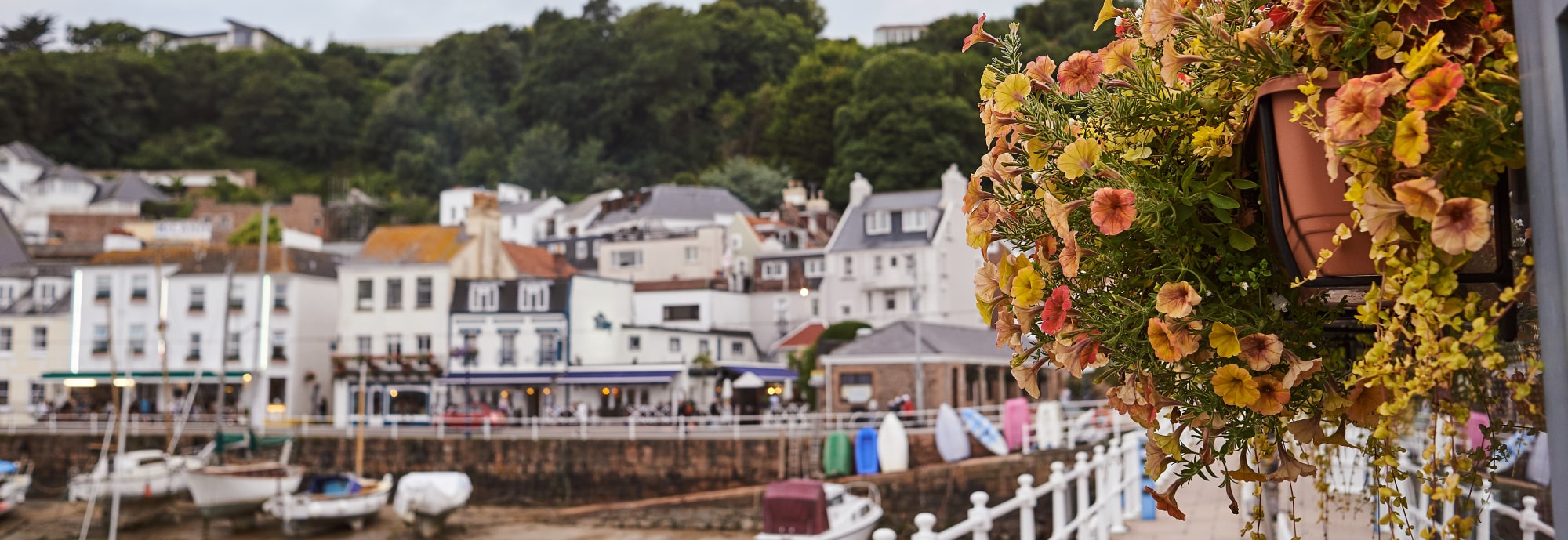St Aubin

Find out about St Aubin’s mercantile history
Since the 16th century, the St Aubin’s fishing fleet was part of the cod trade between Jersey and Newfoundland and many of the local residents were merchants and privateers. Until the 19th century, St Aubin’s harbour was the principal port of the island.
In the early 17th century there was no protective harbour in Jersey so its fleet would have wintered at St Malo. However during mid 17th – 18th century, the island carried out work on the piers at St Aubin’s fort and the South and North piers of the current harbour and so ships could then be anchored in St Aubin for the winter months. In the 16th century, ships unloading their cargo into carts on the beach were vulnerable to attack by pirate vessels from Brittany and Belgium coming into the bay so St Aubin’s fort was built as a defence. A bulwark (earth work) with two guns was constructed on shore, giving the area the name Bulwarks, it still has today. During the 18th and 19th century, the fort was rebuilt twice, but in peaceful Victorian times it was hired out as a summer residence. The fort was then strengthened with turret guns and concrete casemates during the Second World War.
During the 17th century, the younger sons of most Jersey families went to sea to Boston and Newfoundland, beginning their profession at about 13 years old. The cod fisheries in Newfoundland carried fish to Portugal and Spain and other Roman Catholic countries. Charles Robin, born in St Aubin in 1743, founded his well known firm at Gaspe in Canada, as after it had become British the town housed many Jersey families. Returning to Jersey in 1802, he lived in Rue Croquet, and died in 1824. As St Aubin grew in in both size and importance, merchants began to build their houses there and a railway link was built in 1807 between the town and St Helier. You can find where the grand railway terminus station and hotel were located on the site of the present Parish Hall. Before this, the quickest way to drive one end of the bay to the other was by horse and cart.
However in the 1920s, due to several rival bus services operating on the island, passenger numbers on the railway fell, causing financial problems. On 21 June 1929, the company was placed in liquidation, with the hotel later bought by the Parish in 1946 for £2,000. It has been used as the Parish Hall ever since this date.
Historical landmarks

A particular problem in the 16th century was when pirate vessels from Brittany and Belgium roamed the island waters of the Channel, looking for easy prey, such as ships unloading their cargo into carts on the beach at St Aubin. To defend against these attacks, a bulwark (earth work) with two guns was constructed on shore, giving the area its present day name of the ’ Bulwarks’. Another tower housing four more gunners was also constructed on the offshore rocky islet. The parliamentarians, a century later during the Civil War, turned it into a stronger fortress, followed by the Royalists replacing it with granite ramparts and an added tower storey. The fort was rebuilt in the 18th and 19th century and during the peaceful Victorian times it was let as a summer residence. We can see today the turret guns and concrete casemates added to the fort by the Germans in the Second World War as the fort was strengthened once again.
As the community grew in St Aubin, there was a demand for a local church , to avoid the long walk to St Brelade’s Parish Church and back. A petition by the merchants to the Bishop of Winchester complained: “The town is distant from its Parish Church about two miles. The road is difficult by reason of rugged ascents, and a great way on moving sands. The inhabitants are exposed to great fatigue in summer by the scorching heat and in winter by tempestuous winds, from which there is no shelter”. As there was insufficient time to return home between morning and evening services, people would pass the time in an inn near the church. In 1749, the new St Aubin church was in use, however by 1887 it was condemned as unsafe and was replaced by the present St Aubin on the Hill Church. During the late 18th century, Methodism was introduced, causing considerable unrest, but eventually a chapel was built in 1817, and then replaced in 1868 by the building which still stands on the Boulevard. Before building the seafront church you’ll see standing today, Roman Catholics had previously used a hall on Mont les Vaux for many years.
There are six main streets in St Aubin: Victoria Road is the the coast road from St Aubin to Helier; the town centre named Charing Cross; The Bulwarks and Bulwarks Hill (Mont du Boulevard) at the far end; St Aubin’s Hill, or Mont les Vaux; High Street and Market Hill. There are many interesting houses to find on The High Street (Rue Du Crocquet): At the bottom L’Ancienneté was the home of John Janvrin, Peterborough House is named after Francis Jeune, Bishop of Peterborough, who was born there in 1806; and St Magloire was the home of Charles Robin, the famous founder of the cod fishing business on Canada’s Atlantic coast. You’ll see parts of a brook running down the side of Mont les Vaux and along the back of St Brelade’s College, called Egouttepluie (raindrops), which once drove a mill. The brook has been mentioned in records as far back as 1269.
If you walk to the southern end of the picturesque harbour in St Aubin, you’ll find one of the finest 15th century Jersey properties, which is now The Old Court House Inn. The present owners claim that the building can be dated back to 1450, with the front portion of the building originally named ‘Osbourne House’. A wealthy merchant was said to have lived there in the 17th century, when its enormous cellars were built, along with a fireplace bearing the date 1611. Although the property bears the name now ‘The Old Court House’ there is no evidence that it was ever actually used as a courthouse. However, there is some evidence to suggest that it may have served as an Admiralty Court to rule on vessels and cargos captured by privateers in the 17th century. We will let you imagine some of scenes that may have taken place there.
More recently The Old court House featured as Bergerac’s local pub in the 1980s series starring John Nettles.
